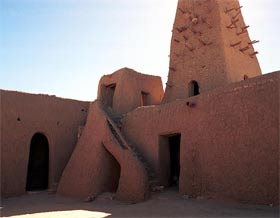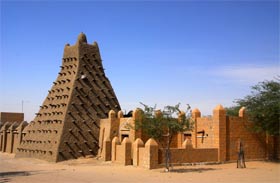
TOMBOUCTOU (TINBUKTU or TIMBUKTU)
 Old Mud Brick House
Old Mud Brick House
 Sankore Mosque
Sankore Mosque
TIMBUKTU, the mysterious, the "saint city" whose creation goes back to the 11th century, was initially nothing but a small transit center for Tran-Saharan caravans. After a long crossing of the Sahara desert, caravans camped around a well belonging to a old woman named BUKTU. That's how the name TIN-BUKTU — meaning BUKTU's well — originated. Over time, it became known as TIMBUKTU.
The small camp developed in a spectacular way because of its strategic position between the SAHARA desert and "river Niger". As an important point between the "Maghreb" and the Sudan, this city played a significant part in the expansion and radiance of Islam.
Also called the "inaccessible," Timbuktu caught the attention of many explorers, from the Scottish MUNGO PARK to the French RENE CAILLE and the German HEINRICH BARTH. The city stood out in the 14th century as the capital of a commerce center between the ancient Sudan and the Maghreb, where the salt of TAOUDENI and the gold of BURE were traded by GHANA merchants as they transited there. The Arab merchants mixed with the travelers and Arabian Muslim philosophers. During this time, Saharan AFRICA was divided into empires which converted to ISLAM and the others.
In TIMBUKTU, the discovery of old documents progresses, some of which some already have been exhumed and listed. After the invasion by Morocco in 1591, and after others factors natural (drought) and human (deceleration of the Tran Saharan commerce), TIMBUKTU entered its fall. It lost a good part of its population, but remained a learning center.
Sites and Curiosities
TOMBOUCTOU is also the site of mysterious libraries, preserving wonderful old literature and documents from centuries-past.
Visit the homes of famous explorers, such as: RENE CAILLE, HENRI BARTH, MUNGO PARK, and GORDON LAING. These homes also contain exhibitions of documents.
